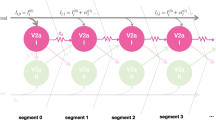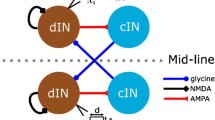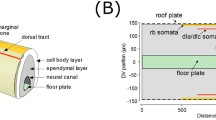Abstract
Locomotion requires longitudinal co-ordination. We have examined uni-directional synaptic coupling processes between two classes of neuronal network oscillators: autonomously active “intrinsic” oscillators, and “potential” oscillators that lack sufficient excitatory drive for autonomous activity. We model such oscillator networks in the bilaterally-symmetrical, Xenopus tadpole spinal cord circuits that co-ordinate swimming. “Glutamate” coupling EPSPs can entrain a second oscillator of lower frequency provided their strength is sufficient. Fast (AMPA) EPSPs advance spiking on each cycle, while slow (NMDA) EPSPs increase frequency over many cycles. EPSPs can also enable rhythmicity in “potential” oscillators and entrain them. IPSPs operate primarily on a cycle-by-cycle basis. They can advance or delay spiking to entrain a second “intrinsic” oscillator with higher, equal or lower frequency. Bilaterally symmetrical coupling connections operate twice per cycle: once in each half-cycle, on each side of the receiving oscillator. Excitatory and inhibitory coupling allow entrainment in complimentary areas of parameter space.
Similar content being viewed by others
References
Bower JM, Beeman D (1997) The Book of Genesis. Springer Telos, Santa Clara.
Buchanan JT (1992) Neural network simulations of coupled locomotor oscillators in the lamprey spinal cord. Biological Cybernetics 66: 367–374.
Cang J, Friesen WO (2000) Sensory modification of leech swimming: Rhythmic activity of ventral stretch receptors can change intersegmental phase relationships. Journal of Neuroscience 20: 7822–7829.
Cohen AH, Ermentrout GB, Kiemel T, Kopell N, Sigvardt K, Williams T (1992) Modelling of intersegmental coordination in the lamprey central pattern generator for locomotion. Trends in the Neurosciences 15: 434–438.
Dale N (1985) Reciprocal inhibitory interneurons in the Xenopus embryo spinal cord. Journal of Physiology 363: 61–70.
Dale N (1995a) Kinetic characterization of the voltage-gated currents possessed by Xenopus embryo spinal neurons. Journal of Physiology 489: 473–488.
Dale N (1995b) Experimentally derived model for the locomotor pattern generator in the Xenopus embryo. Journal of Physiology 489: 489–510.
Dale N, and Roberts A (1985) Dual-component amino-acid— Mediated synaptic potentials: Excitatory drive for swimming in Xenopus embryos. Journal of Physiology 363: 35–59.
Ekeberg O, Wallen P, Lansher A, Traven H, Brodin L, Grillner S (1991) A computer based model for realistic simulations of neural networks: I. The single neuron and synaptic interaction. Biological Cybernetics 65: 81–90.
Ermentrout GB, Kopell N (1990) Oscillator death in systems of coupled neural oscillators. SIAM Journal of Applied Mathematics 51: 125–146.
Grillner S, Matsushima T, Wadden T, Tegner J, ElManira A, Wallen P (1993) The neurophysiological bases of undulatory locomotion in vertebrates. Seminars in Neuroscience 5: 17–27.
Hodgkin AL, Huxley AF (1952) A quantitative description of membrane current and its application to conduction and excitation in nerve. Journal of Physiology (London) 117: 500–544.
Kahn JA, Roberts A (1982) The central nervous origin of the swimming motor pattern in embryos of Xenopus laevis. Journal of Experimental Biology 99: 185–196.
Kopell N, Ermentrout GB (1988) Coupled oscillators and the design of central pattern generators. Mathematical Biosciences 90: 87–109.
Marder E, Kopell N, Sigvardt K (1997) How computation aids in understanding biological networks. In: PSG Stein, S Grillner, AI Selverston, DG Stuart, eds. Neurons, Networks and Motor Behavior. MIT Press, Cambridge. pp. 139–149.
Matsushima T, Grillner S (1990) Intersegmental co-ordination of undulatory movements—A “trailing oscillator” hypothesis. Neuro-Report 1: 97–100.
Matsushima T, Grillner S (1992) Neural mechanisms of intersegmental coordination in lamprey: Local excitability changes modify the phase coupling along the spinal cord. Journal of Neurophysiology 67: 373–388.
Mulloney B, Namba H, Skinner FK, Hall WM (1998) Intersegmental coordination of swimmeret movements: Mathematical models and interneurons. In: O Kiehn et al., eds. Neuronal Mechanisms for Generating Locomotor Activity. Annals of the NewYork Academy of Science 860: 266–280.
Pearce RA, Friesen WO (1988) A model for intersegmental coordination in the leech nerve cord. Biological Cybernetics 58: 301–311.
Roberts A, Dale N, Evoy WH, Soffe SR (1985) Synaptic potentials in motoneurons during fictive swimming in spinal Xenopus embryos. Journal of Neurophysiology 54: 1–10.
Roberts A, Dale N, Soffe SR (1986) Spinal interneurones and swimming in frog embryos. In: Grillner et al., eds. Neurobiology of Vertebrate Locomotion. MacMillan, London. pp. 279–306.
Roberts A, Tunstall MJ (1990) Mutual-reexcitation with postinhibitory rebound: A simulation study on the mechanisms for locomotor rhythm generation in the spinal cord of Xenopus embryos. European Journal of Neuroscience 2: 11–23.
Roberts A, Tunstall MJ, Wolf EW (1995) Properties of networks controlling locomotion in a simple vertebrate and significance of voltage-dependency of NMDA channels: A simulation study of rhythm generation sustained by positive feedback. Journal of Neurophysiology 73: 485–496.
Sigvardt KA (1993) Intersegmental coordination in the lamprey central pattern generator for locomotion. Seminars in Neuroscience 5: 3–15.
Sigvardt KA, Miller WL (1998) Analysis and modeling of the locomotor central pattern generator as a network of coupled oscillators. In: O Kiehn et al., eds. Neuronal Mechanisms for Generating Locomotor Activity. Annals of the New York Academy of Science 860: 250–265.
Sigvardt KA, Williams TL (1996) Effects of local oscillator frequency on intersegmental coordination in the lamprey locomotor CPG: Theory and experiment. Journal of Neurophysiology 76: 4094–4103.
Soffe SR (1987) Ionic and pharmacological properties of reciprocal inhibition in Xenopus embryo motoneurons. Journal of Physiology (London) 382: 463–473.
Soffe SR (1990) Active and passive membrane properties of spinal cord neurons which are rhythmically active during swimming in Xenopus embryos. European Journal of Neuroscience 2: 1–10.
Soffe SR, Roberts A (1982) Tonic and phasic synaptic inputs to spinal cord motoneurones active during fictive locomotion in frog embryos. Journal of Neurophysiology 48: 1279–1288.
Stein PSG (1971) Intersegmental coordination of swimmeret motor neuron activity in crayfish. Journal of Neurophysiology 34: 310–318.
Tabak J, Moore LE (1998) Simulation and parameter estimation study of a simple neuronal model of rhythm generation: Role of NMDA and non-NMDA receptors. Journal of Computational Neuroscience 5: 209–235
Tunstall MJ, Roberts A (1991) Longitudinal coordination of motor output during swimming in Xenopus embryos. Proceedings of the Royal Society B 244: 27–32.
Tunstall MJ, Roberts A (1994) A longitudinal gradient of synaptic drive in the spinal cord of Xenopus embryos and its role in coordination of swimming. Journal of Physiology 474: 393–405.
Wallen P, Williams TL (1984) Fictive locomotion in the lamprey spinal cord in vitro compared with swimming in the intact and spinal animal. Journal of Physiology (London) 347: 225–239.
Zhao F-Y, Burton BG, Wolf ES, Roberts A (1998a) Asymmetries in sensory pathways from skin to motorneurons on each side of the body determine the direction of an avoidance response in hatchling Xenopus tadpoles. Journal of Physiology (London) 506: 471–487.
Zhao F-Y, Wolf E, Roberts A (1998b) Longitudinal distribution of components of excitatory input to motoneurones during swimming in young Xenopus tadpoles: Experiments with antagonists. Journal of Physiology (London) 511: 887–901.
Author information
Authors and Affiliations
Rights and permissions
About this article
Cite this article
Tunstall, M.J., Roberts, A. & Soffe, S. Modelling Inter-Segmental Coordination of Neuronal Oscillators: Synaptic Mechanisms for Uni-Directional Coupling During Swimming in Xenopus Tadpoles. J Comput Neurosci 13, 143–158 (2002). https://doi.org/10.1023/A:1020114324350
Issue Date:
DOI: https://doi.org/10.1023/A:1020114324350




